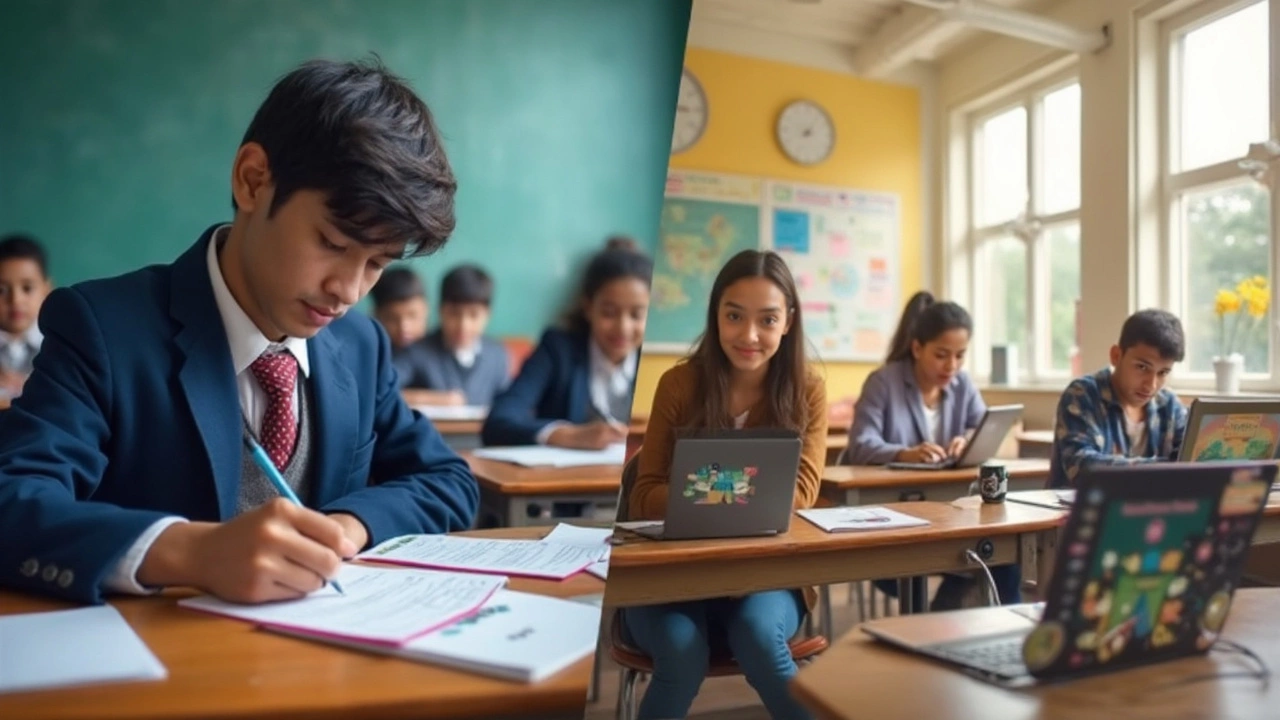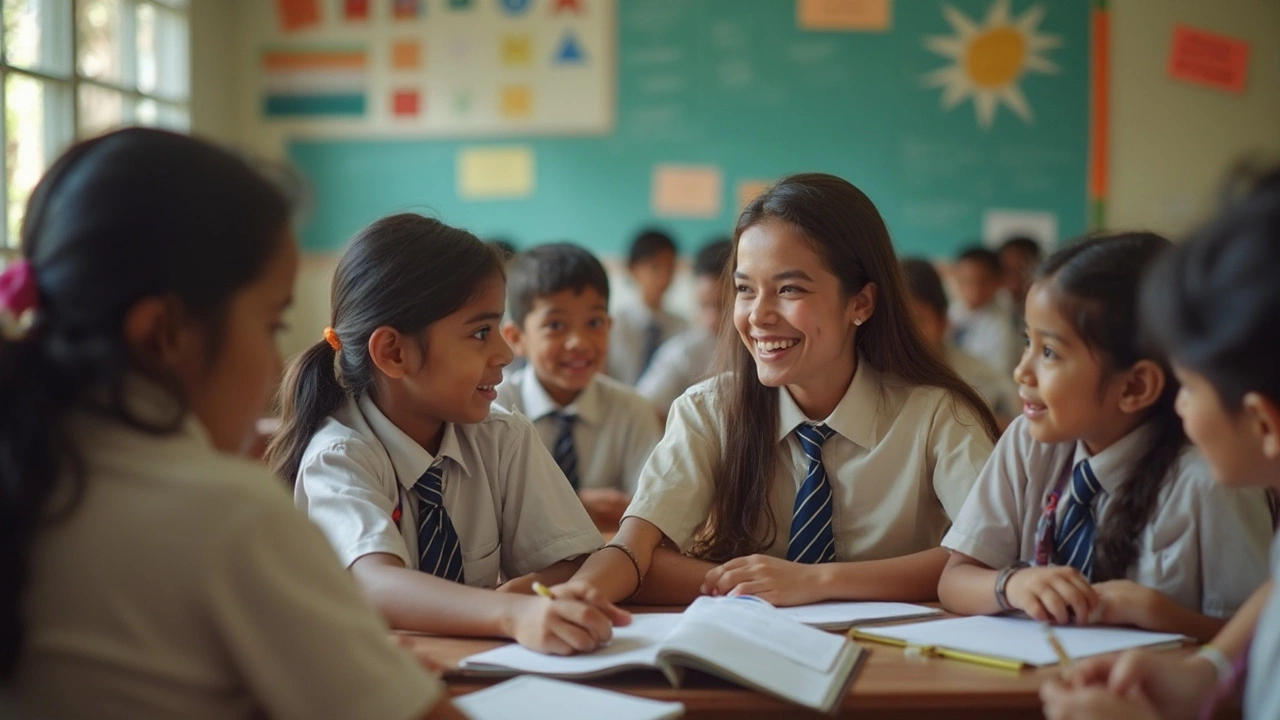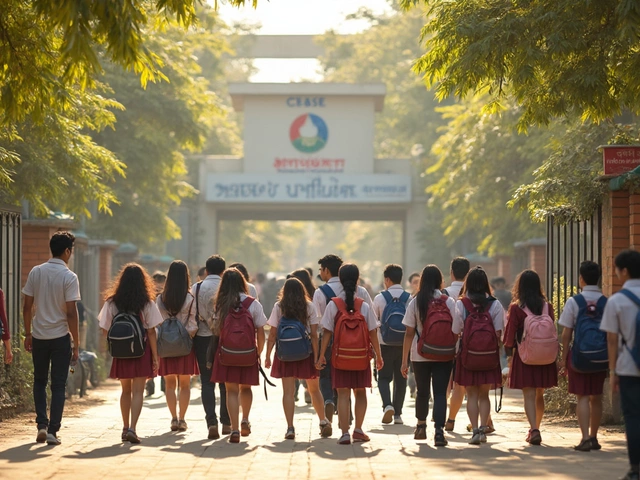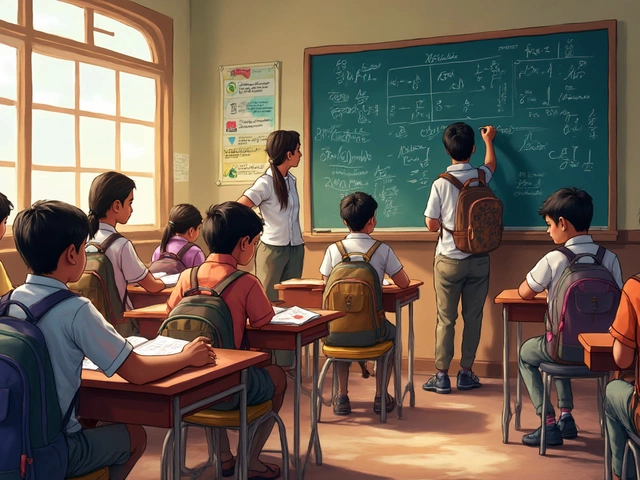Ask anyone who's looked at schools in both the US and India, and you'll hear wild differences—some true, some totally exaggerated. Let’s get straight to what actually matters: what are students learning, how are they being tested, how stressful is it, and does it prepare them for real life?
In the US, schools love flexibility. Students often choose what subjects to take beyond the basics, and there’s plenty of hands-on work—think science projects, not just textbooks. Meanwhile, Indian schools, especially those following CBSE, stick to a set syllabus with clear textbooks and lots of focus on tests. That has its upsides, like clear milestones, but it can feel rigid if you’re used to making your own choices.
Parents sometimes worry: Will switching systems mess up their kid’s future? Good news—most universities understand both systems. What really counts is how well you can show what you know, not just which country you studied in. Stick around to see how daily school life feels, what the biggest challenges are, and what students who’ve made the switch wish they’d known sooner.
- Curriculum and Syllabus Differences
- Teaching Style and Classroom Culture
- Assessment and Exams
- Student Life and Opportunities
- CBSE vs US School System: Real-Life Stories
- Tips for Switching Between Systems
Curriculum and Syllabus Differences
If you stack the Indian CBSE syllabus next to the US curriculum, the first thing you’ll notice? The level of structure. CBSE syllabus is clear-cut. Every student uses the same textbooks, studies the same topics, and faces similar tests—right from grade 1 to 12. This setup is great if you like knowing exactly what’s coming in every grade. In the US, things are way more flexible. Kids start with general subjects in early grades, but by high school, they can pick electives—sometimes even niche ones like carpentry, film, or coding.
Here’s a quick table to highlight the main differences:
| Point | USA | India (CBSE) |
|---|---|---|
| Textbooks | No national standard, schools choose | Strictly NCERT prescribed |
| Subjects | Choice of electives from grade 9+ | Limited, mostly fixed by stream (Science, Commerce, Arts) |
| Learning style | Focus on discussion and projects | Textbook-based, mostly theory |
| Standardization | Varies by state and district | Highly standardized nationwide |
| Foreign Languages | Choices vary, Spanish, French common | Options depend on school, Hindi/English mandatory |
Project work is huge in US schools. For example, science fairs and social studies projects actually count toward your grades. In India, CBSE added project work too, but marks from these rarely make a big dent in your final score. The US also offers Advanced Placement (AP) classes, which are kind of like mini college courses in high school. CBSE is only just starting to experiment with skill-based subjects for practical learning.
A former principal from New York once said,
“Flexibility lets us nurture every student’s strength. We want to make sure kids leave school knowing how to think, not just what to think.”That’s a fair summary of how the US views education.
On the flip side, CBSE is famous for a strong base in math and science—which is why so many Indian students ace competitive exams worldwide. The heavy focus on core subjects sometimes makes students really sharp in tricky subjects like calculus or chemistry by grade 12, but it doesn’t leave as much room for exploring new interests during school hours.
If you’re moving from one country to the other, expect some surprises. CBSE kids switching to the US may find school a bit more chill but less predictable. US kids in India? Be ready for a structured grind and deeper theory in every subject.
Teaching Style and Classroom Culture
Classrooms in the USA and India look and feel pretty different. In US schools, you’ll usually see students sitting in small groups, teachers moving around the room, and lots of back-and-forth discussion. Learning by doing is huge—group projects, presentations, and open debates happen all the time. The vibe is pretty relaxed; students often call teachers by their first names and aren’t afraid to ask questions.
Flip to a typical CBSE classroom in India, and you’ll spot rows of desks, everyone facing the board, and a teacher leading from the front. Respect for authority is key. Don’t be surprised to hear students addressing teachers as “Ma’am” or “Sir”—interrupting isn't really encouraged unless you’re called on. Focus is on discipline and completing the set syllabus.
Here’s a quick side-by-side look:
| Aspect | USA Schools | CBSE Schools (India) |
|---|---|---|
| Teaching Style | Interactive, mix of theory & hands-on | Mainly lecture-based, structured lessons |
| Class Participation | Encouraged, open questions welcomed | Limited, usually when asked |
| Project Work | Frequent group projects | Project work, but less often |
| Student-Teacher Relationship | Casual, friendly | Formal, respectful |
One study from the National Center for Education Statistics found that over 70% of US teachers use group work and projects as part of everyday lessons. In a typical CBSE classroom, the focus still leans toward finishing the textbook and preparing for exams. The balance is shifting slowly, though, with Indian schools starting to mix in hands-on activities, especially in science and math.
A principal from a reputed New Delhi CBSE school shared,
"There’s pressure to cover the entire syllabus before exams. But now we encourage more practical activities and student presentations, so it’s not just rote learning."
So, what’s better? If you want a relaxed environment that rewards questioning, the US system stands out. If you prefer discipline and clear direction, the CBSE setup in India fits the bill. Honestly, both have room to improve. The key is what works best for education system needs: open conversation, or focus and routine?
Assessment and Exams
Here’s where the education system in the USA and India really go their separate ways. In India, especially with the CBSE syllabus, students face big end-of-year board exams that decide a lot. Everything from getting into a good college to family bragging rights can ride on those scores. Exams are usually written papers, mostly with straightforward questions — short answers, long answers, sometimes multiple choice. There’s less room for creativity, and a lot depends on memorizing facts.
In the US, assessment is way more spread out. Teachers use quizzes, projects, presentations, essays, and sometimes even class participation to figure out your grade. Instead of one do-or-die exam, students build up their marks over time. Stress is spread out, but it never completely disappears—deadlines just keep coming. There’s often a mix of multiple-choice, open-ended questions, and group projects, so students learn to work in teams and speak up in class.
Here’s a quick comparison of how both systems assess students:
| Feature | USA | India (CBSE) |
|---|---|---|
| Main Type of Assessment | Continuous (assignments, quizzes, projects, class tests) | Year-end board exams, some internal assessments |
| Weight of Final Exam | 10-40% | 70-100% |
| Emphasis on Memorization | Low to moderate | High |
| Group Projects | Common | Rare |
| Open-Book Exams | Sometimes | Very rare |
| Internal/Continuous Assessment | Integral | Limited |
If you’re coming from CBSE, don’t be surprised that in the US, missing an assignment or project can actually hurt your final grade more than bombing one test. In contrast, Indian students might only have a couple of big chances to prove themselves, so the stakes for each board exam feel huge.
One practical tip: In the US, try to stay on top of small tasks—they add up fast, and teachers track everything. In India, focus on practicing past papers and sample questions, because knowing the pattern can give you a real edge. If you’re thinking about transferring between systems, mastering both approaches makes you more adaptive and less stressed down the line.

Student Life and Opportunities
Daily life for students looks really different depending on where you study. In the USA, school’s not just about books. Students join clubs, play sports, volunteer, and take part in events all through the year. There’s even a dedicated “spirit week” in a lot of American schools, where everyone dresses up on different themes. These experiences build real-world skills and friendships that last way beyond graduation.
Indian schools—especially those following the CBSE syllabus—focus more on academics. There are cultural events and competitions, but you’ll rarely see after-school activities taking up as much time as your homework does. Most CBSE schools are big on Science, Math, and languages, so if you want strong basics, especially for tough entrance exams, you'll get that here.
When it comes to opportunities, the US schools are all about college prep. High schoolers work on projects, try internships, and counselors help you build a solid portfolio. In India, most students focus on scoring high in board exams or prepping for IIT-JEE, NEET, or other big entrances. If you want to study abroad, both systems have alumni who have made it to top global universities. Here’s where you might see some differences:
- Internships: Easier to get in the US, even in high school. Indian students usually start after 12th grade.
- Sports and Arts: Big focus in the US, often with dedicated coaches and scholarships. In India, they’re seen as secondary—unless you’re in a specialized school.
- Student Support: US schools provide counseling and guidance for both academic and personal issues. Indian schools are catching up but aren’t there yet across the board.
- Exposure: US students might travel more for school projects, exchanges, or trips. Some top Indian schools offer this, but it’s not as common.
If you’re weighing your options, think about what matters most for your future. Super strong academics? Go for CBSE. If you’d rather explore interests and build a wider skill set, American schools give you more chances. Both systems have kids who go on to do amazing things—what’s important is using what’s at your school to your advantage.
CBSE vs US School System: Real-Life Stories
Let’s talk about real kids who’ve jumped from a CBSE school to an American classroom, or flipped the script and come the other way. Their stories highlight what works, what trips you up, and how your everyday school life can change in ways you might not expect.
Take Priya, who moved from Delhi to Austin in grade 9. She found the classes in the US full of projects and group work—less memorization, more discussion. At her old CBSE school, marks depended on getting textbook answers word-for-word. In Austin, her teachers wanted her opinion. That was jarring at first, but she says her confidence shot up after a few months.
On the other hand, Rahul did it backwards—he moved from Boston to Mumbai in class 10. His first shock was the volume of homework and the focus on exams. CBSE expects you to know the syllabus inside out, page by page. But he liked the clear structure and how everyone knew exactly what would be on the test. He missed the relaxed vibe of his US classes, but says he got a lot sharper at organizing his time.
If you’re wondering about results, data shows that students coming from the education system in the US often need a few months to get used to CBSE’s exam patterns. On the flip side, students from CBSE sometimes struggle with open-ended assignments in American schools, but they usually crush standardized tests like the SAT thanks to their solid exam practice.
| Transition | Biggest Challenge | Biggest Benefit |
|---|---|---|
| CBSE to US | Adapting to open discussions, less structure | Improved confidence, more creativity |
| US to CBSE | Heavy syllabus, high-stakes exams | Clear expectations, strong fundamentals |
Tips from students who’ve made the move?
- Don’t be afraid to ask for help—teachers in both countries are used to new students catching up.
- Get comfortable with a new style of homework—project-based in the US, detailed written practice in CBSE.
- Use your strengths: CBSE students often excel in standardized tests, US students are pros at presentations and teamwork.
Every system has its quirks. Listening to people who’ve walked both paths can prepare you way better than official guides or school brochures.
Tips for Switching Between Systems
Moving from the Indian CBSE syllabus to a US school—or the other way around—is a pretty big change, but it’s totally manageable with a little planning. The key thing is that the education system works differently in both places. You don’t want surprises messing with your grades or confidence.
Here’s what actually helps:
- Gather school records early: Schools in both countries need detailed transcripts, report cards, and personal details. If you’re leaving India, get all mark sheets and recommendation letters in advance. US schools look closely at grades and personal development, so every file counts.
- Language matters: If you’re heading to the US, sharpen your English speaking and writing skills. US classrooms expect you to speak up and write a ton. If moving to India, get a handle on CBSE-specific terms and even basic Hindi for daily life—you don’t want to feel lost in the hallways.
- Understand subject mapping: The US lets you mix and match classes, so match your CBSE subjects to US equivalents to avoid repeating stuff. For example, advanced math in CBSE often places you ahead in the US system, but some states require local history or US civics too.
- Brace for teaching style changes: Indian schools focus a ton on theory and tests. US schools push class participation and projects. Practise group work and don’t be shy to share ideas—teachers expect it.
- Ask about grading and credits: In India, CBSE marks are everything. The US uses letter grades and GPAs, and sometimes counts classwork as much as exams. Know how your grades will change so nothing seems unfair later.
- Prep for new deadlines: The school year starts and ends at different times. If you're switching mid-year, expect to catch up fast. Don’t be afraid to ask teachers for extra materials or extensions.
The biggest tip? Don’t stress solo. Find other students who’ve gone through the same switch. They’ll have the best hacks for surviving the first month, making new friends, and finding your groove faster.



